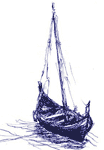1996 — Holmgard Expedition by Viking ship Aifur
Date: July 1996
Route: Demidov (Rus) — Smolensk (Rus) — Gnezdovo (Rus) — Katyn (Rus)

In 1994 and 1996, the reconstructed Swedish Viking Age ship Aifur made a voyage from Sigtuna on lake Mälar in Sweden to the Black Sea port of Kherson in the Ukraine. The venture, called The Holmgard Expedition, was an attempt to navigate the passage from the Varangians to the Greeks, as mentioned in the Russian Primary Chronicle. Much is unknown about the conditions for river communications during prehistoric times. The Aifur expedition was a piece of archaeology by experiment.
The Aifur is 9 meters long, 2,2 meters wide and its hull weighs approximately 800 kgs. Its construction combines features from different Viking Age boats found in the Baltic region. It carried a 19 square meters sail. The ship was manned by a sequence of crews, each consisting of about nine people. The ship derives its name from one of the largest and most dangerous rapids on the Dnieper river.
In 1994, the Aifur crossed the Baltic Sea and sailed up the rivers Neva and Volkhov to Novgorod. Distance covered was 1382 km. In 1996, the ship continued from Novgorod. The river Lovat from Kholm upstream was not navigable due to a very low water level, and the portage over the first watershed therefore became far too long to be practicable — horses were not available. However, the crew continued on the rivers Usvyatya, Dvina and Kasplya, crossing the second watershed by putting the vessel on simple wheels, made on site. The Vikings from Smolensk Viking-Nevo club joined the crew of Aifur on the land stage of the expedition. They helped much with Aifur portage. Including Novgorod to Svetlylahirske on the Dnieper, the distance covered was 1568 km. The combined distance covered, during the 113 days of effective Expedition, was 2950 km.
During the Baltic Sea crossing, on the lakes Ladoga and Ilmen and on the Dnieper dams, the Aifur proved to be a good sailing vessel before the wind and to a certain degree also capable of tacking. Rowing and sometimes sailing downstream on the Dnieper also worked quite nicely. However, although the Aifur is fairly small, the rivers Lovat and Kasplya were navigable only with great effort and difficulty. The adverse stream on the shallow Lovat with its many rapids was especially demanding.
Some conclusions
Experience gained from this expedition shows that only very light vessels would be suitable for the northern part of the historic passage. Even so, it is probable that the upper Lovat and the upper Kasplya may be navigable only after snowy winters and only for a short period each spring. And even then, the traveller on the Lovat would have to master the river’s strong current and many dozens of rapids.
Where exactly the northern part of the passage from the Varangians to the Greeks was situated is, in fact, unclear. Miklyayev and other Russian scholars have also observed that many settlements and cemeteries from the period AD 500-1000 are situated several metres below the level of the present rivers Lovat, Usvyatya etc. Miklyayev has therefore suggested that the waterways in North-West Russia were, therefore, not readily navigable during the Viking Age. According to him, the reason was that the climate was better then. Miklyayev suggests that this part of the passage was instead used in winter. Even in more rainy times — e.g. during the 18th century — the Lovat was, according to written testimony, not very useful for travellers because of its many rapids.
Scandinavians scholars discussing the Viking voyages to the East have shown an obsession with ships. However, by travelling by horse and sledge on the frozen plain and on the ice of rivers and marshes, long distances have been covered in North-West Russia historically in a relatively short time. Several accounts of Viking Age winter travelling, e.g. in Snorre Sturlasson’s work, support the Winter version of the passage from the Varangians to the Greeks.
The southern part of the passage is not questioned. The Dnieper between Smolensk and the Black Sea was a huge, wide river. Two problems have been much discussed by scholars: the ever-present military threat to travellers presented by the nomadic tribes and the hazardous rapids (of which the so-called Aefor/Aifur was one) which were situated between today’s cities Dnepropetrovsk and Zaporozhe. However, the rapids are now covered by hydropower dams and all opportunity for travelling experiments there is unfortunately lost.
More information about the Holmgard Expedition see on the site http://www.geocities.com/aifurship/











